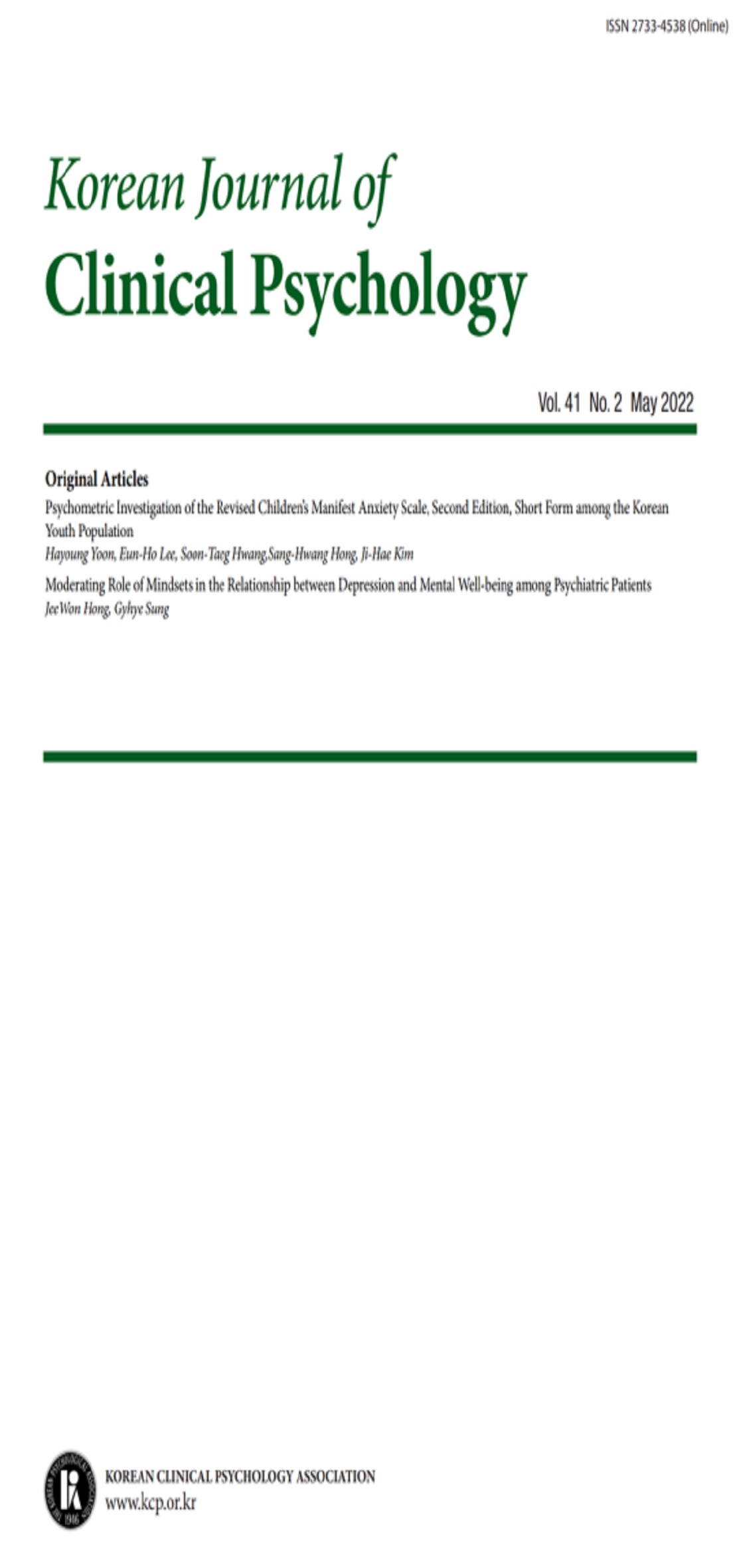open access
메뉴
open access
메뉴 E-ISSN : 2733-4538
E-ISSN : 2733-4538
The purpose of this study is to investigate the relationship between psychopathy and parental abuse during early childhood. A total of 339 college students were evaluated to examine their psychopathic tendencies and were asked to report their childhood parental abuse experience. Partial correlation analyses showed a significant positive correlation between secondary psychopathy and physical abuse, emotional abuse and neglect. However, there was a lack of significant correlation between childhood parental abuse and primary psychopathy. Regression analysis demonstrated that factors such as emotional abuse and neglect were strong predictors of secondary psychopathy. This study suggests that childhood parental abuse is associated with secondary psychopathy, whereas such association is not observed with primary psychopathy.
Arduino, V. (2011). Offending behavior: The role of trauma and PTSD. European Journal of Psychotraumatology, 3, 18968. doi:http://dx.doi.org/10.3402/ejpt.v3i0.18968.
Arduino, V. (2012). Post-traumatic stress in antisocial youth: A multifaceted reality. In V. Arduino (Ed.), Post-traumatic syndromes in children and adolescents (pp. 211-229). Chichester, UK: Wiley-Blackwell.
Brinkley, C. A., Newman, J. P., Widiger, T. A., & Lynam, D. R. (2004). Two approaches to parsing the heterogeneity of psychopathy. Clinical Psychology: Science and Practice, 11, 69-94.
Craparo, G., Schimmenti, A., & Caretti, V. (2013). Traumatic experiences in childhood and psychopathy: A study on a sample of violent offenders from Italy. European Journal of Psychotraumatology, 4, 21471. doi:http://dx.doi.org/10.3402/ejpt.4i0. 21471
Forth, A. E. & Burke, H. C. (1998). Psychopathy in adolescence: Assessment, violence, and developmental precursors. In D. J. Cooke, A. E. Forth, & R. D. Hare (Eds.), Psychopathy: Theory, Research, and Implications for Society (pp. 205-299). Dordrecht: Kluwer.
Harpur, T. J., Hare, R. D., & Hakstian, A. R. (1989). Two-factor conceptualization of psychopathy: Construct validity and assessment implications. Psychological Assessment: A Journal of Consulting and Clinical Psychology, 1, 6-17.
Hong, H. G., & Hyun, M. H. (2008). A decision-making process and response reversal performance ability of individuals with primary and secondary psychopathic tendencies. Korean Journal of Psychology: General, 27, 425-442.
Karpman, B. (1941). On the need of separating psychopathy into two distinct clinical types: The symptomatic and the idiopathic. Journal of Criminal Psychopathology, 3, 112-137.
Karpman, B. (1948). Conscience in the psychopath: Another version. American Journal of Orthopsychiatry, 18, 455-491.
Kim, D. M., & Park, H. J. (2005). Subtyping of psychopathy-like adolescents: Primary psychopaths and secondary psychopaths. The Korea Journal of Youth Counseling, 13, 111-123.
Kim, H. S., Hong, H. G., Choi, H. T., Kang, D. J., & Seo, J.S. (2010). Study on the Dark Triad of personality traits: Narcissism, machiavellianism, primary psychopathy & secondary psychopathy. Korean Journal of Forensic Science, 11, 19-24.
Kim, S. W. (2003) The effect of social support on abused children’s adjustment. (Unpublished master’s thesis). Seoul National University, Seoul, Korea.
Levenson, M. R., Kiehl, K. A., & Fitzpatrick, C. M. (1995). Assessing psychopathic attributes in a non-institutionalized population. Journal of Personality and Social Psychology, 68, 151-158.
Margolin, G., & Gordis, E. (2000). The effects of family and community violence on children. Annual Review of Psychology, 51, 445-479.
Marshall, L., & Cooke, D. J. (1995). The role of childhood experiences in the etiology of psychopathy. Issues in Criminological and Legal Psychology, 24, 107-108.
Mokros, A., Hare, R. D., Neumann, C. S., Santtila, P., Habermeyer, E., & Nitschke, J. (2015). Variants of psychopathy in adult male offenders: A latent profile analysis. Journal of Abnormal Psychology, 124, 372-386.
Porter, S. (1996). Without conscience or without active conscience? The etiology of psychopathy revisited. Aggression and Violent Behavior, 1, 179-189.
Poythress, N., Lilienfeld, S., & Skeem, J. (2006). Associations among early abuse, dissociation, and psychopathy in an offender sample. Journal of Abnormal Psychology, 115, 288-297.
Ross, S. R., Molto, J., Poy, R., Segarra, P., Pastor, C., & Montanes, S. (2007). Gray’s model and psychopathy: BIS but not BAS differentiates secondary psychopathy in noninstitutionalized young adults. Personality and Individual Differences, 43, 1644-1655.
Skeem, J. L., Johansson, P., Andershed, H., Kerr, M., & Louden, J. E. (2007). Two subtype of psychopathic violent offenders that parallel primary and secondary variants. Journal of Abnormal Psychology, 116, 395-409.
Skeem, J. L., Poythress, N., Edens, J. F., Lilienfeld, S. O., & Cale, E. M. (2003). Psychopathic personality or personalities? Exploring potential variants of psychopathy and their implications for risk assessment. Aggression and Violent Behavior, 8, 513-546.
Spertus, I. L., Yehuda, R., Wong, C. M., Halligan, S., & Seremetis, S. V. (2003). Childhood emotional abuse and neglect as predictors of psychological and physical symptoms in women presenting to a primary care practice. Child Abuse and Neglect, 27, 1247-1258.
Weiler, B. L., & Widom, C. S. (1996). Psychopathy and violent behavior in abused and neglected young adults. Criminal Behaviour and Mental Health, 6, 253-271.
Welsh, G. S. (1956). Factor dimensions A and R. In G. S. Welsh & W. G. Dahlstrom (Eds.), Basic readings on the MMPI in psychology and medicine (pp. 264-281). New York: John Wiley & Sons.
